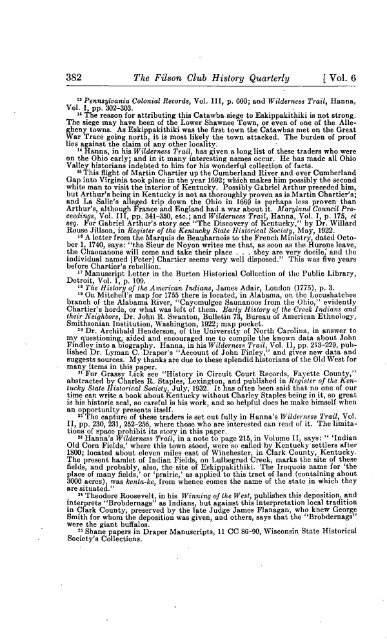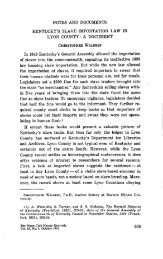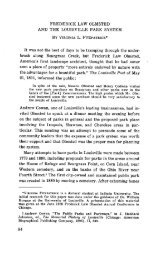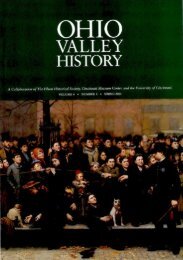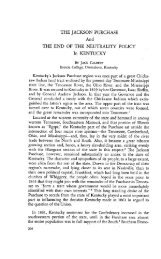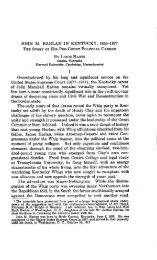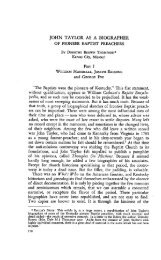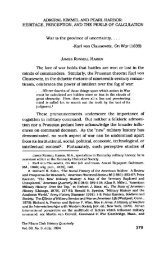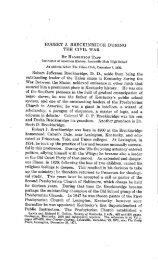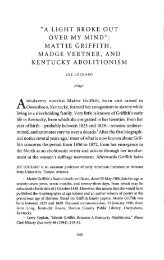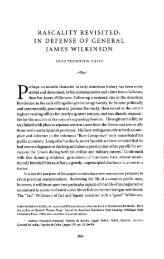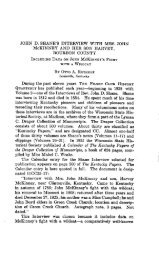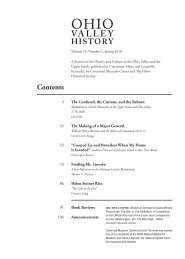Eskippakithiki, The Last Indian Town in Kentucky - The Filson ...
Eskippakithiki, The Last Indian Town in Kentucky - The Filson ...
Eskippakithiki, The Last Indian Town in Kentucky - The Filson ...
Create successful ePaper yourself
Turn your PDF publications into a flip-book with our unique Google optimized e-Paper software.
382 <strong>The</strong> <strong>Filson</strong> Club History Quarterly [ Vol. 6<br />
1 Pennsylvania Colonial Records, Vol. III, p. 660; and Wilderness Trail, Hanna,<br />
Vol. I, pp. 302-303.<br />
1, <strong>The</strong> reason for attribut<strong>in</strong>g this Catawba siege to <strong>Eskippakithiki</strong> is not strong.<br />
<strong>The</strong> siege may have been of the Lower Shawnee <strong>Town</strong>, or even of one of the Allegheny<br />
towns. As <strong>Eskippakithiki</strong> was the first town the Catawbas met on the Great<br />
War Trace go<strong>in</strong>g north, it is most likely the town attacked. <strong>The</strong> burden of proof<br />
lies aga<strong>in</strong>st the claim of any other locality.<br />
14 Hanna, <strong>in</strong> his Wilderness Trail, has given a long list of these traders who were<br />
on the Ohio early and <strong>in</strong> it many <strong>in</strong>terest<strong>in</strong>g names occur. He has made all Ohio<br />
Val ey historians <strong>in</strong>debted to him for his wonderful collection of facts.<br />
16 This flight of Mart<strong>in</strong> Chartier up the Cumberland River and over Cumberland<br />
Gap <strong>in</strong>to Virg<strong>in</strong>ia took place <strong>in</strong> the year 1692" which makes him possibly the second<br />
white man to visit the <strong>in</strong>terior of <strong>Kentucky</strong>. ossibly Gabriel Arthur preceded him,<br />
but Arthur's be<strong>in</strong>g <strong>in</strong> <strong>Kentucky</strong> is not as thoroughly proven as is Mart<strong>in</strong> Chattier's;<br />
and La Salle's alleged trip down the Ohio <strong>in</strong> 1669 is perhaps less proven than<br />
Arthur's, although France and England had a war about it. Maryland Council Pro.<br />
ceed<strong>in</strong>gs, Vol. III, pp. 341-350, etc.; and Wilderness Trail, Hanna, Vol. I, p. 175, et<br />
seq. For Gabriel Arthur's story see "<strong>The</strong> Discovery of <strong>Kentucky</strong>," by Dr. Willard<br />
Rouse Jillson, <strong>in</strong> Register of the <strong>Kentucky</strong> State Historical Societ;d, May, 1922.<br />
1, A letter from the Marquis de Beauharnois to the French M<strong>in</strong>istry, dated October<br />
1, 1740, says: "the Sieur de Noyon writes me that, as soon as the Hurons leave,<br />
the Chaouanons will come and take their place . . . they are very docile" and the<br />
<strong>in</strong>dividual named [Peter] Chartier seems very well disposed." This was We years<br />
before Chartier's rebellion.<br />
DJManuscripttroit ", Vol . ,p. Letter1 09. <strong>in</strong> the Burton Historical Collection of thc uhlio ibrary,<br />
is <strong>The</strong> History of the American <strong>Indian</strong>s, James Adair London (1775) p. 3.<br />
tg On Mitchell's map for 1755 there is located, <strong>in</strong> Alabama, on the Locushatchee<br />
branch of the Alabama River "Cayomulgee Saunanoos from the Ohio " evidently<br />
Chartier's horde or what was left of them. Early History of the Creek <strong>Indian</strong>s and<br />
their Neighbors, J r. John R. Swanton, Bullet<strong>in</strong> 73 Bureau of American Ethnology,<br />
Smlthsonian Institution, Wash<strong>in</strong>gton, 1922; map pocket.<br />
20 Dr. Archibald Henderson, of the University of North Carolbm, <strong>in</strong> answer to<br />
my question<strong>in</strong>g, aided and encouraged me to compile the known data about John<br />
F<strong>in</strong>dley<strong>in</strong>to a biography Hanna <strong>in</strong> his Wilderness Trail, Vol lI pp 213-229 pub-<br />
. , . • 2 •<br />
hshed Dr. Lyman C. Draper's " ccount of John F<strong>in</strong>ley," and gives new data and<br />
suggests sources. My thanks are due to these splendid historians of the Old West for<br />
many items <strong>in</strong> this paper.<br />
2t For Grassy Lick see "History <strong>in</strong> Circuit Court Records, Fayette County,"<br />
abstracted by Charles R. Staples, Lex<strong>in</strong>gton,and published <strong>in</strong> Register of the <strong>Kentucky</strong><br />
State Historical Society, July, 1932. It has often been said that no one of our<br />
time can write a book about <strong>Kentucky</strong> without Charley Staples be<strong>in</strong>g <strong>in</strong> it, so great<br />
is his historic zeal so careful is his work, and so helpful does he make himself when<br />
an opportunity presents itse f.<br />
<strong>The</strong> capture of these traders is set out fully <strong>in</strong> Hanna's 1Vilderness Trail, Vol.<br />
II pp 230 231 252-256 where those who are <strong>in</strong>terested can read of it. <strong>The</strong> llmitatmns<br />
of space prohibit its story <strong>in</strong> this paper.<br />
23 Hanna's Wilderness Trail, <strong>in</strong> a note to page 215, <strong>in</strong> Volume II, says: " '<strong>Indian</strong><br />
Old Corn Fields,' where this town stood, were so called by <strong>Kentucky</strong> settlers after<br />
1800; located about eleven miles east of W<strong>in</strong>chester, <strong>in</strong> Clark County, <strong>Kentucky</strong>.<br />
<strong>The</strong> present hamlet of <strong>Indian</strong> Fields, on Lulbegrud Creek, marks the site of these<br />
fields and probably, also, the site of <strong>Eskippakithiki</strong>. <strong>The</strong> Iroquois name for 'the<br />
place of many fields,' or 'prairie,' as applied to this tract of land (conta<strong>in</strong><strong>in</strong>g about<br />
3000 acres) was kenta-ke from whence comes the name of the state <strong>in</strong> which they<br />
are situate .:<br />
' <strong>The</strong>odore Roosevelt <strong>in</strong> his W<strong>in</strong>n<strong>in</strong>g of the West publishes this deposition, and<br />
<strong>in</strong>terprets "Brobdernags" as <strong>Indian</strong>s, hut aga<strong>in</strong>st this <strong>in</strong>terpretation local tradition<br />
<strong>in</strong> Clark County, preserved by the late Judge James Flanagan, who knew George<br />
Smith for whom the deposition was given, and others, says that the "Brohdernags"<br />
were the giant buffalos.<br />
2a Shane papers <strong>in</strong> Draper Manuscripts, 11 CC 86-90, Wiscons<strong>in</strong> State Historical<br />
Society's Collections.


